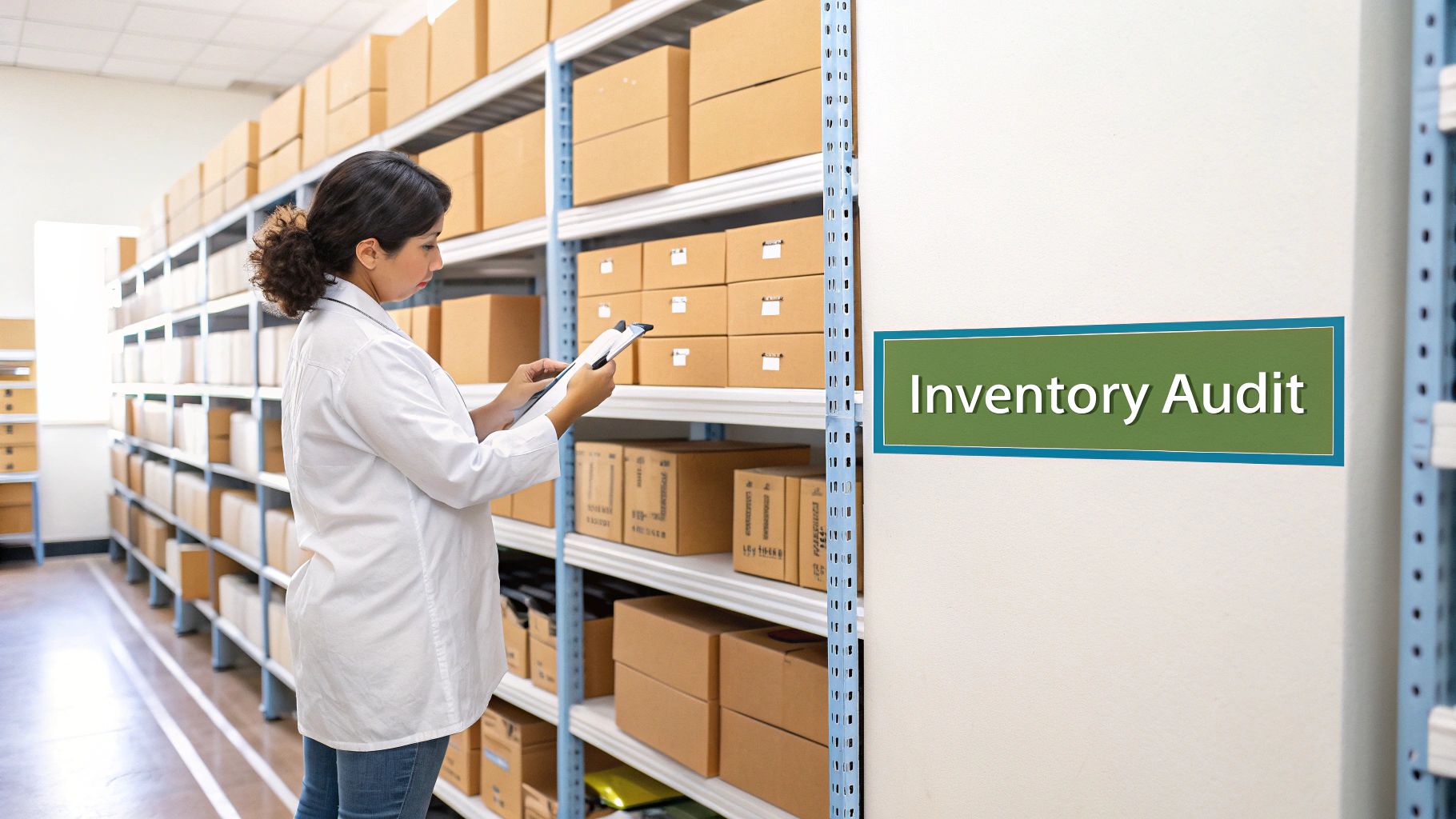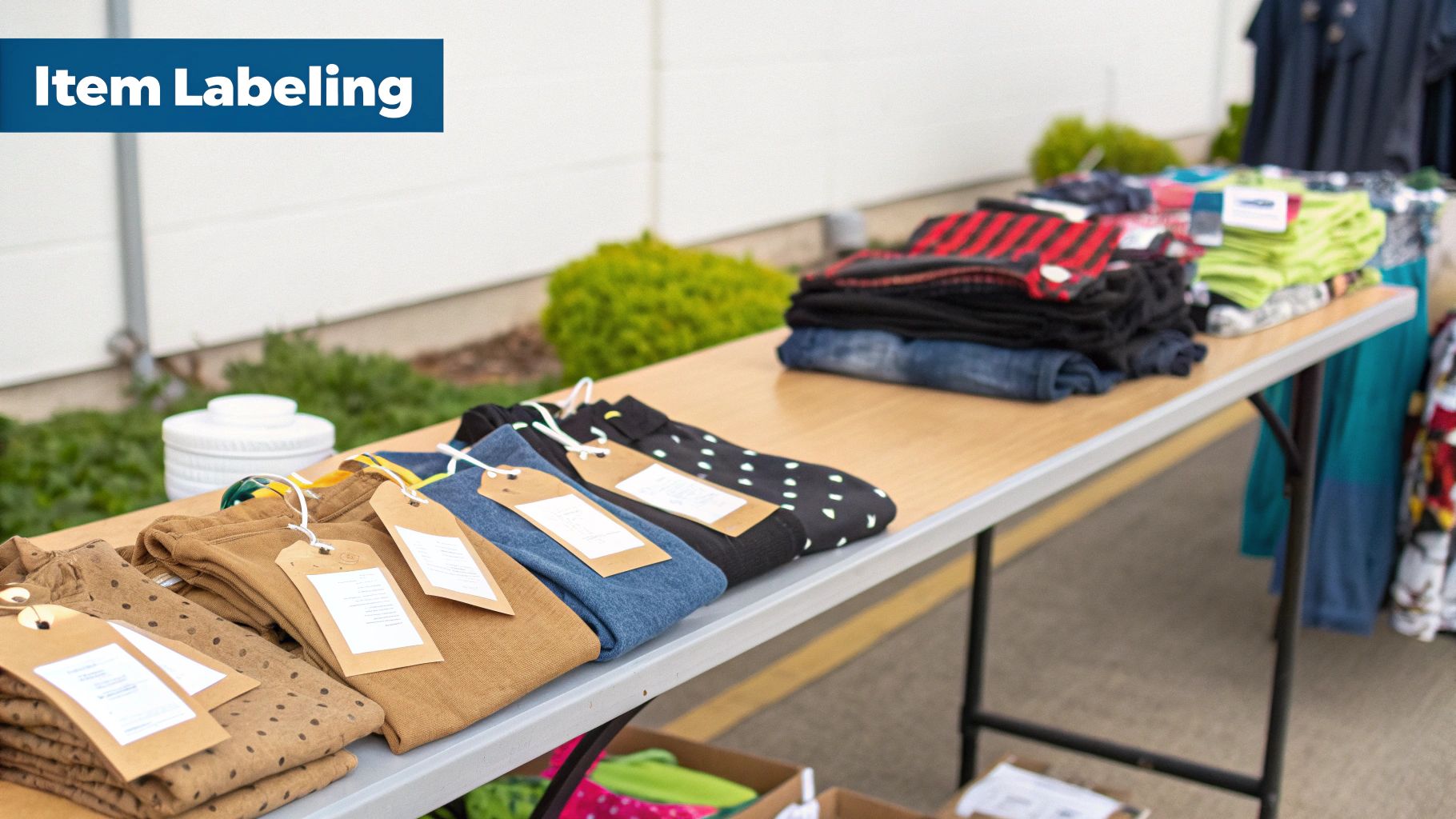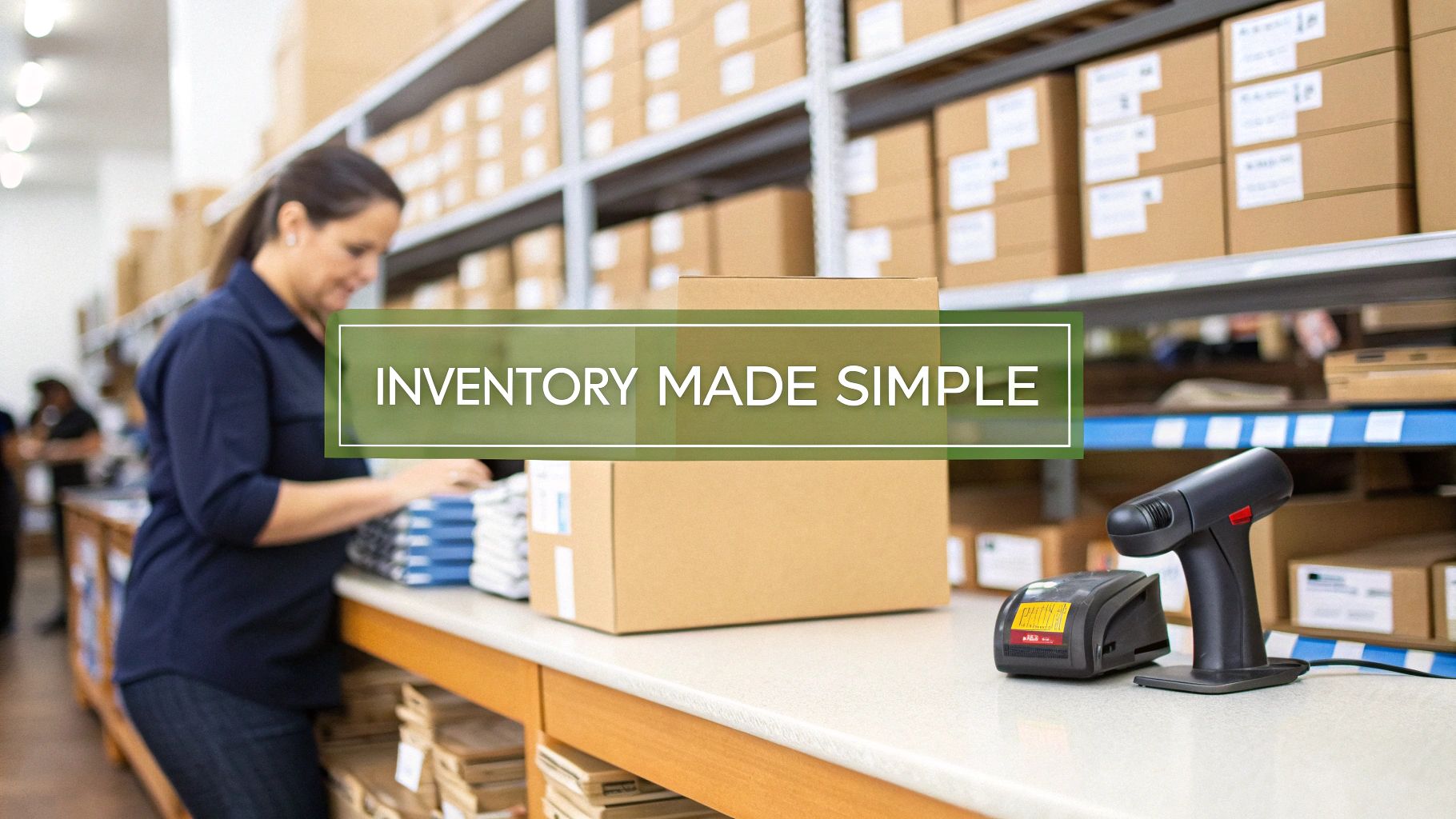Let's be honest: managing a thrift store's inventory is like trying to catch rain in a bucket. It’s a constant, unpredictable flood of one-of-a-kind items. This isn't your typical retail gig where neat boxes with clean SKUs show up on a schedule. Your "supply chain" is a stream of donations, each one a mystery box of treasures and, well, other stuff.
This is the beautiful chaos of the secondhand world. You’re not just managing products; you're curating a collection. One day it's vintage vinyl and designer jeans, the next it’s a mid-century armchair and three bags of kids' clothes. This is what makes running a thrift store so unique—and what makes managing it so tough.
The Reality of Thrift Store Inventory Chaos
If you've ever felt like your backroom is in a state of "organized chaos," you're not alone. That's the default setting for most thrift stores. The real challenge is bringing genuine organization to that chaos without losing the magic.
And things are only getting more intense. We're in the middle of a massive secondhand boom. Younger shoppers, especially, are all in on thrifting. In fact, a whopping 62% of Gen Z and Millennials say they now check for an item secondhand before even thinking about buying it new. More customers and more donations sound great, but it puts a serious strain on your entire operation. You can get a deeper look at this trend from these insights on the booming thrift market from retailcontrolsystems.com.
This surge creates a perfect storm that basic retail systems just weren't built for.
- You can't predict your inventory. Donations come when they come. You might get ten bags one hour and a hundred the next.
- Everything is a one-off. Forget standard SKUs. Every single t-shirt, book, and coffee mug is unique.
- Pricing is an art form. There's no supplier price list. You're pricing based on brand, condition, what's trending, and pure gut instinct.
Why a Solid System Is No Longer Optional
For years, plenty of thrift shops got by just fine with a pen-and-paper log or a clunky spreadsheet. Those days are over. With so much stuff coming in and so many shoppers walking through the door, that old-school approach is a recipe for disaster. You’ll lose track of valuable items, slap the wrong price on things, and create a frustrating mess for your staff and customers.
A great inventory system is your game plan for turning that unpredictable flow of donations into profit. It's what helps you sort, price, and sell every item for what it's truly worth.
The idea isn't to get rid of the "organized chaos"—that's part of the fun of thrifting! The goal is to build a smart, sturdy framework around it. This guide will walk you through exactly how to do that, step by step, so you can tame the unpredictability and build a stronger, more profitable store.
How to Choose the Right Inventory Software

Let's be honest: moving away from a manual spreadsheet is the single biggest leap forward your thrift store can make. While that trusty Excel sheet might feel simple and free, it quickly becomes a tangled mess. It’s slow, prone to human error, and can't give you the real-time information you need to make smart decisions.
The right software, on the other hand, changes the game completely. It helps you get a handle on the beautiful chaos of donated goods and shifts your strategy from just reacting to what comes in the door to proactively managing your floor.
But here’s the catch: not all software is built the same. A generic retail point-of-sale (POS) system might look tempting, but it almost always falls short because it doesn't understand the thrift world. You aren't ordering neat boxes of identical SKUs from a supplier; you're dealing with an unpredictable flood of one-of-a-kind items, each with its own story and condition.
Your Non-Negotiable Features
When you start looking at software, you need to zero in on the features that solve the unique problems of secondhand retail. These are the things that separate a genuinely helpful tool from a source of daily frustration.
Your thrift store inventory management software absolutely must have:
- Donation Tracking: A simple way to log donations the moment they arrive, noting where they came from and the general category. This is ground zero for your entire inventory process.
- Barcode Generation and Scanning: Creating a unique barcode for every single item is non-negotiable. This is how you track an item from the backroom to the sales floor and finally to the checkout, giving you a goldmine of data.
- Condition-Based Pricing: The system has to let you set prices based on an item's actual condition (new with tags, gently used, minor flaws), not just a flat price for every "shirt" or "book."
- Clear Sales Reporting: You need easy-to-read dashboards that show you what's flying off the shelves, what’s collecting dust, and which categories are actually making you money. This information is the bedrock of your pricing and stocking strategy.
A huge mistake I see people make is choosing a system based on price alone. A cheap or "free" option that can't handle unique items or give you decent reports will end up costing you far more in lost sales and wasted time.
Specialized vs. General Retail Software
The main decision you'll face is whether to go with a system designed specifically for thrift stores or a more general retail POS. While some general systems have gotten better, they rarely grasp the specific workflows that secondhand stores depend on every single day.
To help you see the difference, here’s a quick comparison of the options.
Feature Comparison of Thrift Inventory Software Types
This table breaks down the key features of specialized thrift software versus general retail systems to help you decide which tool is right for your store.
| Feature | Specialized Thrift Software (e.g., TPM) | General Retail POS (e.g., KORONA POS) | Manual System (Spreadsheets) |
|---|---|---|---|
| Donation Management | Built-in module for tracking donors, sources, and donation types. | Usually requires a workaround or doesn't exist. | Completely manual entry; hard to track donor history. |
| Unique Item Processing | Designed for one-of-a-kind items with unique identifiers and condition notes. | Can be cumbersome; designed for standard SKUs with fixed attributes. | Extremely difficult; leads to inconsistent data. |
| Pricing by Condition | Core feature, allowing for variable pricing within the same category. | Limited or non-existent; often relies on price overrides. | Relies on employee memory or handwritten notes. |
| Color Tag/Rotation System | Often has automated features for managing aging inventory and discount cycles. | Manual process; requires running reports and manually applying discounts. | Impossible to automate; very labor-intensive. |
| Real-Time Reporting | Robust dashboards showing category performance, sales velocity, and donor value. | Good sales data, but may lack thrift-specific insights (e.g., item lifecycle). | No real-time data; reports must be built manually. |
| Ease of Use for Staff | Intuitive for thrift workflows (receiving, sorting, pricing). | May confuse staff with irrelevant retail features (e.g., purchase orders). | High potential for error and requires training on formulas. |
As you can see, the specialized tools are built from the ground up with your reality in mind. That's why major players like Goodwill Industries of Northwest Texas use cloud-based systems like the Thrift Production Manager (TPM). They found it delivered 5 times faster processing of back-office tasks and gave their staff real-time dashboards to make better pricing decisions on the spot.
Key Questions to Ask Before You Buy
Once you’ve narrowed down your options, schedule a live demo. Don't let the salesperson just click through a polished presentation. You need to come armed with questions that push the software to see if it can handle your real-world scenarios.
Here’s what I’d ask:
- How do you handle one-of-a-kind items? Show me, step-by-step, how I'd add a unique vintage dress versus a common paperback book.
- Can you walk me through an item's entire life? I want to see how it's logged at donation, priced in the back, put on the floor, and finally sold at the register.
- What does your markdown process look like? Can I set up an automatic discount for items with a certain color tag? How easily can I pull a report of everything that’s been on the floor for over 30 days?
- Show me a report that will actually help me run my business. I want to see a report that clearly identifies my best and worst-selling categories from last quarter.
Asking pointed questions like these forces them to show you practical value, not just rattle off a list of features. It helps you truly picture how the software will fit into your daily grind.
To get a better sense of what your customers are looking for—and what inventory you should prioritize—check out our guide on essential thrift store shopping tips. Picking the right software is the first real step toward building a smarter, more profitable store.
Designing an Efficient Donation Processing Workflow

Let's be honest, the magic on your sales floor starts in the chaos of the backroom. This is where a mountain of unpredictable donations gets turned into treasure. Without a solid system, that "organized chaos" quickly becomes just chaos—a bottleneck that swallows inventory, kills profits, and leaves your sales floor looking stale.
The secret is to create a predictable path for every single item. Think of it like a well-oiled assembly line. This isn't about taking the fun out of thrifting; it's about building a framework that lets you process more of those unique finds, faster.
Setting Up Your Workflow Stations
Your backroom isn't just one big storage closet. It’s a series of workstations, each with a specific job. Breaking the process down this way makes training volunteers and staff a breeze and keeps donations moving forward. You don't need a huge warehouse, just a smart, logical flow.
Here’s a simple, proven station setup that works in almost any space:
- Receiving & Initial Sort: This is ground zero. As soon as a donation comes through the door, it lands here. The first job is a quick triage—separating the obvious trash from the good stuff. Use big, clearly labeled bins for your main categories like "Clothing," "Housewares," "Media," and "Trash."
- Quality Control & Cleaning: Once sorted, items move to this station for a little TLC. This is where you'll wipe down hard goods, spot-treat a garment, or test that old lamp to see if it works. Make sure this area is equipped with basic cleaning supplies and a power strip for testing electronics.
- Pricing & Tagging: Cleaned and prepped items are now ready to be priced. This is where your inventory software really starts to shine. Your team will assess the item's condition, generate a unique barcode or SKU from your system, and attach the price tag securely.
- Final Staging: The last stop before the sales floor. Priced and tagged items get organized onto rolling racks or into department-specific bins. This makes restocking a snap—just grab the "Women's Jeans" rack and roll it out.
This station-based approach stops piles from forming and ensures every donation is handled with purpose. It creates a forward momentum that is absolutely critical for effective thrift store inventory management.
The Triage System for High-Value Finds
Look, not all donations are created equal. One of the biggest mistakes I see stores make is treating a vintage Coach bag with the same process as a generic t-shirt. This is where a simple "triage" system for high-value goods can be a game-changer.
During that initial sort, train your team to spot items that have the potential to be big moneymakers. We're talking about recognizable designer brands, unique vintage pieces, collectibles, or anything that might do better online.
Here's a tip from the trenches: Set up a "treasure chest" bin right at the sorting station. When a sorter spots a pristine Dooney & Bourke purse, a signed book, or a cool piece of mid-century art, it goes into this bin instead of the regular flow. A manager or your most experienced pricer should then review this bin daily to research and price these items appropriately, either for your online shop or a locked display case.
This one simple step can stop you from accidentally pricing a $100 item for $5, massively boosting your store's average sale price.
A Smart Tagging Strategy for Inventory Rotation
Your tagging system should do more than just display a price—it should be a tool for managing your inventory. A color-coded tagging strategy is one of the simplest, most effective ways to track inventory age and automate your markdowns.
Here’s how you can implement it:
- Assign a color to each week. For example, all items stocked in the first week of the month get a green tag. Week two gets blue, week three gets yellow, and week four gets red.
- Run sales based on tag color. After a month, those green-tagged items are your oldest inventory. You can then run a store-wide sale: "This week, all green tags are 50% off!" Customers quickly learn to hunt for the sale color.
- Pull old stock systematically. At the end of the sale week, it’s easy to spot any leftover green-tagged items. Pull them from the floor to be sent to an outlet bin, bundled, or recycled.
This turns inventory rotation from a massive, dreaded project into a simple, ongoing weekly task.
With a workforce of around 140,000 people in the U.S. thrift industry, managing this constant flow of goods is a huge operational challenge. Modern inventory tools are key to preventing overstocking and keeping the entire system running smoothly. Software solutions are now widely used to automate this kind of inventory control, optimizing space in both tiny boutiques and massive superstores. You can learn more about how these systems support thrift operations on koronapos.com.
Using Data to Make Smarter Pricing and Stocking Decisions

A good inventory system is so much more than a simple list of what you have. When you get it right, it becomes your strategic playbook. It’s the difference between guessing what your customers want and knowing what they’ll buy before it even hits the floor.
Honestly, relying on gut feelings is a recipe for a cluttered backroom and missed sales. The moment you start digging into the data from your POS and inventory software, every decision about pricing and stocking gets sharper, smarter, and way more profitable. It tells you the real story of your store—what’s flying off the shelves, what’s collecting dust, and where your money is actually being made.
Pinpointing Your Winners and Losers
Every thrift store I've ever worked with has its rockstars and its shelf-warmers. Your first job is to use your sales reports to figure out which is which. Don't just settle for broad categories like "clothing." You need to get granular.
For instance, your reports might show that "vintage denim" sells within a week, but "men's formal wear" sits for months on end. Or maybe you'll discover that "mid-century modern decor" is a surprise hit. This is the kind of intelligence you can act on immediately.
- Winners: These are your fast-movers. Once you know what they are, you can train your sorters to spot them, price them for maximum value, and give them prime real estate on the sales floor.
- Losers (Dead Stock): These are the items that suck up resources. They take up precious space that could be used for things that actually sell. Identifying them is the first step toward getting them out of your system.
If your team uncovers a really unique, high-value piece, it's worth doing a little extra digging. Our guide on how to sell vintage items can give you some great pointers on capturing its full market value.
Good data gives you the confidence to make tough calls. Instead of wondering if you should accept another box of old encyclopedias, you can look at the numbers and see that you haven't sold a single one in a year. Decision made.
Crafting a Data-Backed Donation Policy
Armed with all this knowledge, you can finally build a smarter donation policy. This isn't about being picky; it's about being strategic. When you know for a fact what doesn't sell, you can politely decline those items right at the source. Think of the hours of sorting and disposal fees you'll save.
Create a clear "We're unable to accept" list based directly on your sales data. Post it on your website and at your donation drop-off area. It's also a good idea to give your staff a friendly, simple script to explain why you can't take certain items. This data-driven approach takes all the emotion and guesswork out of the conversation.
Optimizing Your Pricing Strategy
Pricing in a thrift store is part art, part science. Your sales data is the science part. By analyzing your reports, you can see exactly how price impacts sales speed for different types of items. Are your designer jeans priced too low and selling out instantly? Are your housewares priced too high and just not moving?
This data allows you to make some powerful adjustments:
- Fine-Tune Your Price Points: Set standard prices for common categories (like a basic t-shirt or a paperback book) and then adjust them based on brand, condition, and the actual demand you see in your data.
- Plan Effective Markdowns: A color-coded tag system is great, but it's even better when paired with data. Your reports will tell you which color tags are getting old, allowing you to plan targeted sales that clear out inventory without giving away the store.
- Run Smarter Seasonal Promotions: Your reports will highlight clear seasonal trends. You can get ahead of the game and price Halloween costumes appropriately in October or winter coats in November, maximizing your return during peak demand.
We're seeing real results from stores that embrace this. One shop reported a 15% reduction in inventory errors and saved 10 hours of manual work a week after implementing a POS system with solid analytics. You can learn more about how data helps in these findings on thrift store operations from redracksthriftstores.com.
Tying Your In-Store and Online Sales Together

If you're serious about growing your thrift store, selling online isn't just a nice-to-have anymore; it's a must. But trying to manage your physical store alongside platforms like eBay, Poshmark, or Shopify can feel like you're spinning plates. The secret? Stop thinking of them as two different businesses.
Your online and in-store stock should be treated as one pool of inventory from the moment it comes through your door. This mindset needs to start at the sorting station, way before anything gets a price tag. A truly effective multichannel strategy relies on a single thrift store inventory management system that can track a sale whether it happens online or on your floor.
Let's be honest, the biggest nightmare is the "double sale." That's when an item sells on your website just minutes after a customer walks out of your store with it. It’s a fast way to get bad reviews and sink your online reputation. A smart, unified workflow is your only real defense against this.
What’s Worth Selling Online?
Not every donation is cut out for e-commerce. You need a fast, almost instinctual process for cherry-picking the items that justify the extra work of photographing, listing, and shipping. This decision has to happen during your initial sort.
Train your team to be treasure hunters, looking for items that check specific boxes for online sales.
- High-Value Brands: Keep a cheat sheet of designer brands that people actively search for. Think vintage Levi's, Frye boots, or recognizable handbags. These are your bread and butter.
- Niche Collectibles: Your local shoppers might walk right past a rare vinyl record or a specific comic book, but a dedicated collector online will pay top dollar.
- New With Tags (NWT): Anything still in its original packaging is gold. It’s an easy sell, requires minimal condition descriptions, and appeals to bargain hunters looking for brand-new quality.
- The Weird and Wonderful: Don't underestimate the power of unique. That wild 1970s lamp or hand-painted jacket might just be the quirky statement piece someone is hunting for on Etsy.
A simple rule of thumb I've always stood by is the "$20-plus" rule. After a quick search on your phone, if you think an item can realistically sell for more than $20, it’s worth pulling for e-commerce. This buffer ensures your profit margin covers the extra labor involved.
How to Prevent the Dreaded Double Sale
This is the most critical part. Once you've flagged an item for online sale, it must be physically and digitally pulled from your regular store inventory. No exceptions.
Create a dedicated "online processing" area in your backroom—a specific shelf, bin, or rolling rack. Once an item lands there, it is off-limits for the sales floor. This is your e-commerce pipeline.
This is where your inventory software becomes your best friend. As soon as that item is flagged, it gets entered into the system with a status like "Online Processing" or "Awaiting Photography." This keeps it from showing as available in your POS. Once it's listed on a marketplace, a good inventory system will sync across all channels, automatically taking the listing down everywhere the second it sells.
Shipping Unique Items Without Losing Your Shirt
Thrifted goods aren't like standard retail products. You can’t just have three standard box sizes and a flat shipping fee. Every single item is a different shape and weight.
The best approach is to weigh and measure each item before you list it online. All you need is a basic shipping scale and a measuring tape. This lets you use the calculated shipping feature on platforms like eBay, which charges the buyer the exact postage based on their zip code. It takes the guesswork out of it for you.
Another popular method is to roll the shipping cost into the item price and offer "free shipping." For instance, if you know a pair of jeans costs around $8 to ship and you want to make $25, you'd list them for $33 with the "free shipping" tag.
The online resale world is booming. The market in the U.S. is on track to hit USD 40 billion by 2029, blowing past the offline market. By building a system that connects your physical and digital shelves, you're setting your store up to grab a piece of that growth. You can dive deeper into these trends by checking out this article on the future of thrift retail on koronapos.com.
Answering Your Top Inventory Questions
Even with a solid system, running a thrift store means you'll face some tricky inventory situations. It’s just the nature of the business. Here are my answers to some of the questions I hear most often from store owners and managers.
How Do I Price Unique Items Consistently?
Pricing one-of-a-kind donations without a system can feel like guesswork. The key is to create a simple, repeatable framework that anyone on your team can follow.
First, set a baseline price for broad categories. For example, maybe all non-designer blouses start at $6, and all hardcover books are $3. This gives your team a solid starting point. Then, empower them to adjust that price up or down based on specific factors like the brand name, the item's condition, or even current fashion trends.
Your team's best friend here is their smartphone. A quick search on eBay's "sold" listings or a scan with Google Lens can show what a similar item is actually selling for online. I also highly recommend creating a laminated pricing guide with photos of common brands and their typical price points. This builds consistency and helps everyone feel confident in their decisions.
Remember, the goal is to sell it, not to store it. Moving inventory with a fair, consistent price is always better than letting a "perfectly" priced item collect dust for months.
What’s the Best Way to Reduce Theft and Shrinkage?
In the thrift world, a good defense is your best offense against theft. It all starts with the store environment itself. A clean, well-lit, and organized shop with clear sightlines makes it much harder for things to walk out the door unnoticed.
Don't underestimate the power of friendly, attentive staff. A simple "Hello, let me know if you need anything!" when someone walks in is a surprisingly effective deterrent. For your higher-value items, it’s wise to use a locked display case or keep them behind the counter. For everything else, a good tagging system where tags are tough to remove without damaging the item can make a huge difference.
Finally, a modern POS that tracks an item from the moment it's donated to the moment it's sold is your secret weapon. It creates a digital paper trail that makes it incredibly difficult for inventory to just disappear.
How Often Should I Do a Full Inventory Count?
Honestly, trying to do a full, wall-to-wall inventory count in a thrift store is a recipe for a headache. With unique items flowing in and out constantly, it's an almost impossible task that doesn't provide much value. A much better approach is cycle counting.
Instead of trying to count everything at once, you count small, manageable sections of your store on a rotating schedule. It might look something like this:
- Monday: All menswear
- Tuesday: Housewares and kitchen goods
- Wednesday: Books and media
This method is way less disruptive to your daily operations. It helps you spot discrepancies much faster and maintains a consistently accurate picture of your inventory without ever having to close your doors for a massive count. Many modern POS systems are even built with features to make cycle counting a breeze.
Of course, knowing what's valuable is part of the equation. You can learn more about identifying the best thrift store finds and what makes them special.
Ready to uncover the history and value of your unique finds? Curio acts as an antique expert in your pocket. Snap a photo to instantly identify items, get an estimated appraisal, and explore their fascinating stories. Download Curio today and turn your thrifted treasures into known treasures. https://www.curio.app
